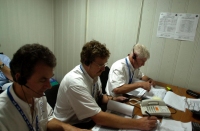Launch Campaign Summary
10 August 2000
The first members of the Cluster II launch campaign team arrived in Baikonur on 27 April 2000. The 33 strong team included staff from Dornier Satellitensysteme, Matra-Marconi Space, TGI (spacecraft support), Europassistance (medical support), Starsem (launch services) and ESA.Preparations
Over the weeks building up to the Cluster launch, the launch campaign team worked hard to ensure the satellites were fully assembled and in perfect working order. Members of the ESA Cluster II team regularly reported on their progress, their entries can be read in the Baikonur launch campaign diary.
After the successful launch of the first Cluster pair, Project Manager John Ellwood praised the Cluster team saying, "Everyone on the ground has done a fantastic job. It has been a very hard working environment, with a lot of working even on Sundays. It is largely due to the tremendous efforts of the ESA team and the industrial consortium led by Astrium GmbH that we are in this excellent position today."
'Name the Cluster quartet' competition
Members of the public in all of ESA's 15 member states were asked to suggest the most suitable names for the Cluster II spacecraft. The satellites were known only as flight models (FM) 5, 6, 7 and 8.
 |
|
The winner of 'name the cluster quartet' competition (4th from the left), Raymond Cotton from Bristol (UK) |
After sifting through more than 5000 entries from all over Europe, and debating at length the merits of the various suggestions, the multinational jury eventually produced a list of 15 national prize winners, one from each ESA member state.
The winning names for the four spacecraft were announced at the ESOC event to mark the first Cluster II launch. The lucky overall winner was Raymond Cotton, a civil servant from Bristol in the UK. Raymond's winning names for the individual Cluster satellites were Rumba (FM 5), Salsa (FM 6), Samba (FM 7) and Tango (FM 8).
"I am very surprised and pleased," said Mr Cotton. "We thought of these names because my wife and I both like ballroom dancing, and they seemed to fit with the movement of the satellites through space. The names are also international and will be recognised in any country."
Launch of Salsa and Samba
The first Cluster pair, Salsa and Samba, was launched from Baikonur on 16 July after an initial attempt the previous day was aborted in the final minute of the countdown. Project Manager John Ellwood was watching the launch from the viewing area just 1 km away from the launch pad.
 |
|
Lift-off for the first Cluster pair. Baikonur, 16 July 2000 |
"There was a crackling roar as the vehicle was held down for 20 seconds while its engines went to half thrust - it almost looked as if it was struggling to escape. Lift-off was quite slow, but it accelerated very quickly. At first it seemed to rise vertically, but then it turned as it headed into the distance."
"We were still in contact with the Starsem people in the bunker and they gave us a 'countdown' on how things were going every 10 seconds - every time it was absolutely nominal. It was a major relief once we knew that the first Fregat burn had gone OK and the satellites were in orbit."
Launch of Tango and Rumba
As scheduled, on 9 August 2000 at 17:13 local time (13:13 CEST), the Soyuz lifted off from pad 6, carrying the second pair of spacecraft in the Cluster quartet. Hundreds of scientists around the world watched with bated breath as the vehicle soared into a clear blue sky with its precious payload.
 |
|
Lift-off of Soyuz launcher carrying the second Cluster pair, Baikonur, 9 August 2000 |
Although the Fregat and its Cluster satellites, Rumba and Tango, were safely installed in their initial preliminary orbit, some 200 km above the Earth, one more vital manoeuvre remained - the second burn of the Fregat main engine. This major landmark took place out of contact from ground stations as the upper stage passed over Africa.
Spontaneous clapping from everyone concerned marked the announcement by Alan Smith, Cluster Mission Director at the European Space Operations Centre in Darmstadt, Germany, that the ground station in Kiruna (Sweden) had acquired signals from both Rumba and Tango. The second Cluster pair had separated from the Fregat and were following their individual elliptical paths which took them between 250 and 18 000 km above the Earth.
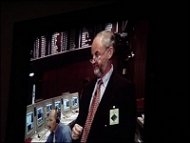 |
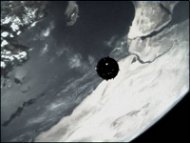 |
|
Alan Smith, Cluster Mission Director at ESOC, Darmstadt |
VMC image of Cluster (Tango and Rumba) separation |
About three hours after launch, the 430 gram Visual Monitoring Camera (VMC) attached to the base of Cluster spacecraft FM 5 (Rumba) sent colour pictures from space showing the separation of the two unmanned satellites. The series of 27 images taken 3 seconds apart show the lower spacecraft (FM8 - Tango) spinning away against the background of the blue and white Earth.
Cluster press event, Royal Society London
During the second Cluster launch a special media event was held at the Royal Society in London, several hundred VIPs and guests responded enthusiastically to the afternoon's events.
In a statement read by Dr Ian Corbett, Director of Science of the UK Particle Physics and Astronomy Research Council, the UK Science Minister Lord Sainsbury said, "This is a major achievement for ESA and its partners, particularly following the tragic demise of the first mission."
"We've done what we promised we would do in 1996," said John Credland, ESA's Head of Scientific Projects Department. "It's fantastic."
"I am tremendously pleased to be here and watch such a perfect launch," said Colin Hicks, Director General of the British National Space Centre.
 |
 |
 |
|
Colin Hicks, Director General of BNSC |
John Credland, ESA Head of Science Projects |
Howard Nye, ESOC Ground Segment Manager and Katie Haswell, presenter |
Cluster Project Scientist Philippe Escoubet paid tribute to the scientists who had endured the long wait before their hard work came to fruition. "It's a big day for the science world," he said. "Some of the scientists have been working on this mission for 15 years. They have overcome adversity to revive Cluster and raise it from the ashes." With a broad smile he added, "We're now looking forward to bringing the quartet together, commissioning the experiments and then analysing a flood of exciting data over the next two years."
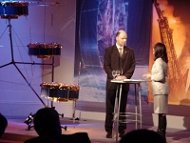 |
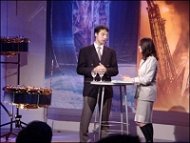 |
|
Dr Andrew Fazakerley, Principal Investigator for PEACE and Katie Haswell, presenter |
Philippe Escoubet, ESA Project Scientist and Katie Haswell, presenter |





